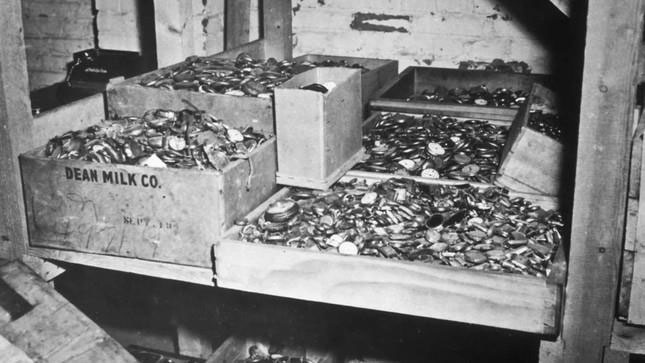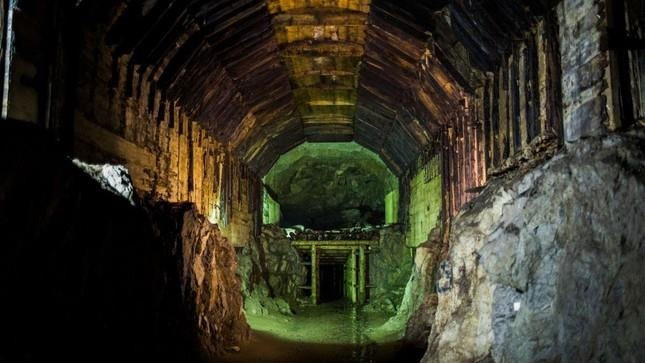Massive Nazi treasures still exist?
Many of these treasures are still missing to this day. Many people believe that the Nazis hid these treasures in secret locations. Did the gold stolen and hidden by the Nazis really exist?

Nazi gold coins discovered.
The answer is yes: Not only was Nazi gold real, but it was also the impetus to liquidate Hitler's regime. As Nazi forces spread across Europe, their policy was to rob their victims of valuables, mostly from Jews. This includes fine art, jewelry, oriental rugs, silverware, porcelain and glassware. But the most important commodity, economically, is gold.
At least nine large boxes filled with gold coins and jewelry were collected by the Nazis from the victims. These were found in a cave adjacent to the Buchenwald concentration camp.
Thousands of gold coins and jewelry collected by the Nazis and found by the US Army in a cave adjacent to the Buchenwald concentration camp in May 1945 in Weimar, Germany. German SS guards removed valuables from the corpses of the victims in their camp to salvage the gold.
Nazi gold is an umbrella term that includes monetary gold, held by governments in central banks as part of their monetary reserves, and items of value stolen from private individuals. kernel (usually not gold).

The mysterious underground Nazi city of Riese is where the legendary Nazi Golden Train is said to be hidden.
Ronald Zweig, professor of Israel studies at New York University and author of the book "The Golden Train: The Destruction of the Jews and the Looting of Hungary" (William Morrow, 2002), says: "This is not something stolen from the victims. We know that the Germans stole the monetary gold reserves of all the national banks of the countries they occupied, and only 70% of them. that money was recovered after the war'.
Typically, the Nazis seized monetary gold and stored it in central archives, then used it to fund the Nazi war effort. But the Nazis also stole gold from individuals. 'Non-monetary gold is derived from the looting of homes, properties and even the bodies of victims,' Zweig writes in his book. Much of what was plundered from individuals was lost or confiscated at the end of the war.
In 1945, U.S. Army units unearthed hidden loot stores across Germany and Austria. The most spectacular discovery was the Merkers salt mine in Thuringia, Germany, which contained gold bullion, coins and currency worth $517 million in 1945 (about $8.5 billion today).
According to Zweig, when Allied forces took control of the occupied territories, an attempt was made to redistribute monetary gold to the countries in which it was occupied. Some of the loot obtained from individual victims was auctioned off to the public. However, other recovered treasures were sold and proceeds were given to organizations established to help Jewish refugees after the war.
The total value of the gold and other assets that the Nazis looted remains uncertain. Early reports of loot "created an El Dorado in Central Europe," Zweig writes in his book.
Many stories of Nazi gold vaults are recorded
Many people believe that not all the looted gold hoards are discovered. However, Ian Sayer, the British historian of the Second World War and co-author of the book "Nazi Gold: The Sensational Story of the World's Greatest Robbery - and the Cover-Up" greatest criminals" (Congdon & Weed, 1985), remains skeptical when such stories appear in the media.
When the unauthenticated "Michaelis" diary - believed to have been written by a Waffen Schutzstaffel (SS) officer using the pseudonym "Michaelis" - was first reported in 2020, it purportedly revealed 11 locations. where the Nazis stashed gold, jewelry, priceless paintings and religious objects.
Another story about the location of the Wałbrzych gold train is said to contain a Nazi gold mine. The ship is believed to be buried inside a mountain in southwestern Poland. When the site was extensively excavated at the site in August 2016, no gold and no trains were discovered.
Ronald Zweig's book "Golden Train" is about a real-life gold train that left Budapest full of Nazi gold, jewelry, and silver that had been stolen from Hungarian Jews. The train was heading towards a Nazi stronghold somewhere in the Alps. The train stopped in Böckstein, Austria, hidden in the Tauern tunnel.
Some of the spoils were taken and buried in various locations throughout Tyrol (a western Austrian state) and Feldkirch (a medieval town in western Austria), and were later discovered. performed by local farmers and the French army after the war ended. The ship's spoils were seized by the US armed forces in May 1945. But some of the hidden loot was never revealed.
However, the Tripartite Commission on Monetary Gold Sanctions (TGC), established in 1946 to recover gold stolen by the Nazis and return it to its rightful owner, could not be completed. until all the Nazi gold listed in the records is returned.
Before the Nazi Gold Conference of that year, in order to finalize the work of the TGC, the Bank of England issued a new statement revealing the exact amount of gold held by the TGC.
- Diary revealed the location of Nazi treasures
- 'World War II' treasure unexpectedly found in ancient castle in Poland
- The treasures in the legend are not yet found
- Found a ghost train containing treasures 70 years ago
- A bunch of abandoned Nazi bunkers 70 years after World War II
- 10 huge treasures were found thrilling, with treasures of nearly 250,000 billion
- Treasure legend: Amber room (Part 2)
- The truth about Nazi 'weapons of death'
- Syndrome K: Mysterious disease and spectacular trick for Nazi Germany?
- 5 knowledge treasures are destroyed by humans
- Mysterious fascist symbols in the German forest
- Nazi Nazi regime chocolate bombs assassinate British Prime Minister
 Biography of hero Vu A Dinh
Biography of hero Vu A Dinh History of hematology
History of hematology Who is Mr. Tam Da 'Phuc-Loc-Tho' and what does it mean?
Who is Mr. Tam Da 'Phuc-Loc-Tho' and what does it mean? Unbelievable facts about the history of the oil and gas industry: Gasoline used to be cheaper than water, so abundant that it had to be dumped into the river...
Unbelievable facts about the history of the oil and gas industry: Gasoline used to be cheaper than water, so abundant that it had to be dumped into the river...